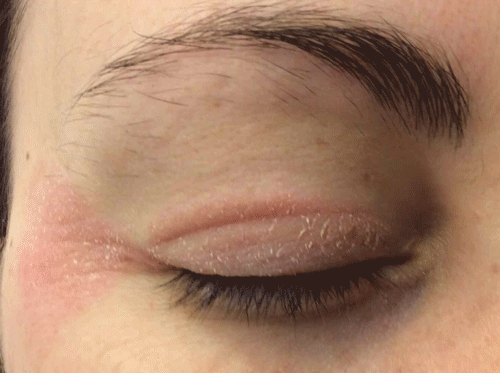If you’ve ever experienced a rash after using a new skin care product, wearing jewelry or touching a plant like poison ivy, you’ve likely had allergic contact dermatitis. Allergic contact dermatitis is a common skin condition that occurs when the skin reacts to an allergen, resulting in rash, redness, itching and irritation. While allergic contact dermatitis can be frustrating and uncomfortable, understanding the causes, symptoms and treatments can help you manage and prevent it in the future.
Dr. Joel Schlessinger, board-certified dermatologist, Mohs surgeon and cosmetic surgeon, explains, “Hundreds, if not thousands, of ingredients touch our skin each day. Some are from nature and some are in products we apply or are exposed to via air or water. It is actually incredible that of these, only a few actually cause an allergic reaction that can create irritation or a rash on the skin.”
“Dermatologists are often able to find out the cause via their assessment of the irritation and the products that you’ve been exposed to during your daily activities.”
In this article, we’ll explore:
- What is allergic contact dermatitis?
- What are the causes and symptoms of allergic contact dermatitis?
- How is allergic contact dermatitis diagnosed and treated?
- Allergic contact dermatitis prevention for healthy skin
What is allergic contact dermatitis?
Allergic contact dermatitis is an allergic reaction that occurs on the skin when the immune system perceives a substance as harmful. The skin reacts by becoming red, inflamed, itchy or irritated. The rash caused by allergic contact dermatitis can be very uncomfortable but isn’t contagious.
Allergic contact dermatitis appears on the skin where it has been exposed to the substance that is causing the reaction. For example, this rash may appear on the face where you applied a skin care cream or on the leg where you may have come into contact with poison oak.
Some allergic contact dermatitis cases are caused by a process called skin sensitization, where an allergic reaction happens when the immune system overreacts to a particular substance after repeated exposure.
Dr. Daniel Schlessinger, a board-certified dermatologist, Mohs surgeon and cosmetic surgeon, explains, “Unlike an immediate allergic reaction, allergic contact dermatitis develops over time and starts about four to seven days after exposure. When the skin is exposed to an allergen, it can become sensitized, leading to an inflammatory response.”
Other types of contact dermatitis include:
- Irritant Contact Dermatitis: The most common type of contact dermatitis, this reaction occurs when a substance directly damages the skin, such as harsh soaps, detergents or chemicals. Unlike ACD, ICD is not caused by an immune response.
- Photocontact Dermatitis: A reaction that happens when a substance on the skin responds to UV light exposure, triggering inflammation and irritation. This type of reaction can occur after using certain sunscreens, fragrances or medications.
What are the causes and symptoms of allergic contact dermatitis?
There are many everyday substances that can cause allergic contact dermatitis. Common triggers include certain skin care and hair care ingredients, fragrances, dyes and metals (most commonly nickel). Once sensitized, allergic contact dermatitis usually appears within minutes to a few hours of an exposure, making it important to identify and avoid the culprit ingredient or substance.
Dr. Daniel Schlessinger explains, “Even a small amount of exposure to an allergen can trigger allergic contact dermatitis. This allergic reaction often leads to painful symptoms, including itching, swelling or blisters on the skin that may require treatment.”
“It’s important to see a board-certified dermatologist early to help identify the cause of your allergic contact dermatitis and create a recovery plan,” he adds.
How is allergic contact dermatitis diagnosed and treated?
If you suspect you have allergic contact dermatitis, a board-certified dermatologist can help pinpoint the exact cause and recommend the best course of action. One of the most effective tools for diagnosing allergic contact dermatitis is patch testing. This process helps identify specific allergens by exposing your skin to small amounts of common triggers.
Dr. Joel Schlessinger explains, “Patch testing is a crucial step in identifying what’s causing your allergic reaction. By knowing the exact allergen, you can take the right steps to avoid it and prevent flare-ups in the future.”
Once a dermatologist has assessed your skin and diagnosed your allergic contact dermatitis, treatment will focus on soothing skin irritation and preventing further exposure. Your dermatologist may recommend:
- Topical corticosteroids, such as FixMySkin 1% Hydrocortisone Healing Body Balm – Fragrance-Free
- Avoiding the allergen and switching to hypoallergenic skin care products
- Cool compresses to comfort skin and reduce swelling, redness and irritation

Dr. Joel Schlessinger adds, “Healing allergic contact dermatitis is more than just treating the symptoms, it’s about identifying the culprit, protecting the skin and preventing future reactions. Gentle, fragrance-free skin care helps to promote faster healing.”
Allergic contact dermatitis prevention for healthy skin
Once you’ve identified the cause of your allergic contact dermatitis, there are steps you can take to maintain healthy, clear and balanced skin. Start by checking ingredient labels to avoid known allergens and looking for products that are fragrance-free or specifically formulated for sensitive skin. Ingredients count, and LovelySkin is a great resource to find products that meet your needs and won’t cause allergies.
Be mindful of jewelry and accessories—nickel is a common trigger, so opt for nickel-free options when possible. You can also protect your skin by using protective gloves when handling harsh products like hair dyes and cleaning solutions. Neosporin is also a very common cause of allergic contact dermatitis, especially when used on cuts or open wounds.
Dr. Daniel Schlessinger shares, “Many people don’t realize how common allergic contact dermatitis is until they experience it firsthand. By making small changes like switching to more chemical-free skin care products and being aware of potential allergens, you can reduce your risk of future flare-ups.”
If you’re experiencing allergic contact dermatitis, skin rash or other concerning skin sensitivities, it’s easy to visit our appointment portal and schedule an appointment with Drs. Joel and Daniel Schlessinger.
